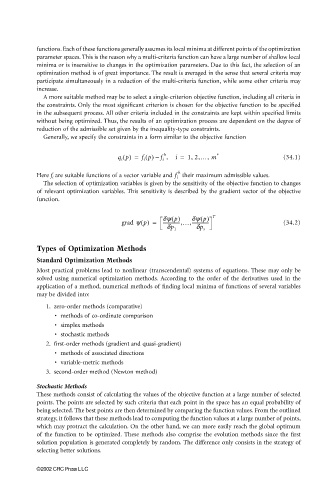Page 1007 - The Mechatronics Handbook
P. 1007
0066_frame_C34.fm Page 3 Wednesday, January 9, 2002 8:07 PM
functions. Each of these functions generally assumes its local minima at different points of the optimization
parameter spaces. This is the reason why a multi-criteria function can have a large number of shallow local
minima or is insensitive to changes in the optimization parameters. Due to this fact, the selection of an
optimization method is of great importance. The result is averaged in the sense that several criteria may
participate simultaneously in a reduction of the multi-criteria function, while some other criteria may
increase.
A more suitable method may be to select a single-criterion objective function, including all criteria in
the constraints. Only the most significant criterion is chosen for the objective function to be specified
in the subsequent process. All other criteria included in the constraints are kept within specified limits
without being optimized. Thus, the results of an optimization process are dependent on the degree of
reduction of the admissible set given by the inequality-type constraints.
Generally, we specify the constraints in a form similar to the objective function
q i p() = f i p() f i , i = 1, 2,…, m ∗ (34.1)
h
–
h
Here f i are suitable functions of a vector variable and f i their maximum admissible values.
The selection of optimization variables is given by the sensitivity of the objective function to changes
of relevant optimization variables. This sensitivity is described by the gradient vector of the objective
function.
dy p() dy p() T
grad y p() = ---------------,…,--------------- (34.2)
dp 1 dp s
Types of Optimization Methods
Standard Optimization Methods
Most practical problems lead to nonlinear (transcendental) systems of equations. These may only be
solved using numerical optimization methods. According to the order of the derivatives used in the
application of a method, numerical methods of finding local minima of functions of several variables
may be divided into:
1. zero-order methods (comparative)
• methods of co-ordinate comparison
• simplex methods
• stochastic methods
2. first-order methods (gradient and quasi-gradient)
• methods of associated directions
• variable-metric methods
3. second-order method (Newton method)
Stochastic Methods
These methods consist of calculating the values of the objective function at a large number of selected
points. The points are selected by such criteria that each point in the space has an equal probability of
being selected. The best points are then determined by comparing the function values. From the outlined
strategy, it follows that these methods lead to computing the function values at a large number of points,
which may protract the calculation. On the other hand, we can more easily reach the global optimum
of the function to be optimized. These methods also comprise the evolution methods since the first
solution population is generated completely by random. The difference only consists in the strategy of
selecting better solutions.
©2002 CRC Press LLC

